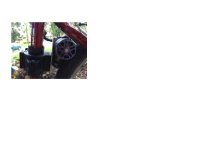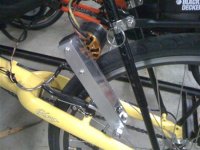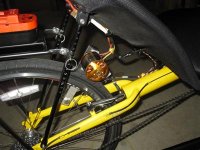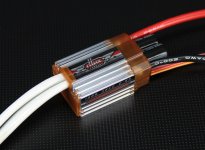Hey Bill...the last two months my life has gotten a complete makeover, pretty much all good news! A far cry from renting a room on the cheap side of town for $200 a month a couple years ago.
willywatts, If an RC motor starts to bog down, it can "lose its place". Its called "losing sync", and it makes an ugly noise while you are sensing a sudden loss of power. The motor is brushless, so the ESC determines precisely where each magnet is located (while its spinning) by sensing the magnetic pulses. I've heard it called "back EMF" but I don't really understand the physics of it. I'll bet getting a Castle Creations ICE-100 ESC will fix it.
You can raise the volts to get more power so it will bog down less (which may require getting a motor with a lower kV), or get a motor with a larger diameter (which will give the rotor more leverage). You will never find a friction drive as small and light as a motor-shell drive like Kepler and Adrian (and your build). If you are content with 22-MPH, I believe the Aeolian 63mm diameter motor with a low 170-kV using 6S LiPo (22V) has a lot of satisfied customers.
If you use a separate roller (like I do) you have a lot of options. My generic Chinese 120A ESC had a loss of sync often. The Hobbywing 70A had a loss of sync under hard acceleration at 22V but not at 37V, and my Castle Creations ESC never had a loss of sync at any voltage under any conditions. The Castle ESC has a more sophisticated electronics filtering capability using high-quality components, but it is more expensive.
I experimented with differently priced ESCs to see what is the cheapest that would work for my application, since I wanted to sell a few (no longer trying to sell any). If you only want one friction drive build, save a few bucks up and just buy the Castle ESC. For a motor-shell drive, get a 100A model, if the roller is separate from the motor a 60A is adequate.
If you have the roller as a separate part from the motor, the drive will be larger, and more complex, but...a one-inch roller with a 63mm motor has a dozen different options (kV from 170-295), and is a great hill climber at 37V.
If you are interested, you could mail me your kit and $150 (I want to buy a CycleAnalyst), and I'll send you my prototype (I'm keeping the V2 in the build-log), it has a 1-1/4 inch roller and a Castle Creations ESC that will run 18V (5S) up to 28V (8S). It would also include a throttle cable, a servo-tester to use as a throttle, and extra input capacitors. I have a spare 63mm 250-kV motor to go with it that should provide 15-MPH at 22V...and maybe 22-MPH at 28V.
If you buy a 295-kV 63mm motor (like the one I have from Exceed), 28V should get you 24-MPH. If you want to go to 37V-44V, you'll need a different ESC.
 I haven't programmed the esc yet could that possibly be it? also to create more friction I wrapped the motor in skateboard grip tape. if anyone has any suggestions at all please let me know I could really use some help to get this project rolling
I haven't programmed the esc yet could that possibly be it? also to create more friction I wrapped the motor in skateboard grip tape. if anyone has any suggestions at all please let me know I could really use some help to get this project rolling  thanks!
thanks!






